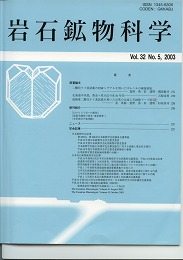最新号
選択された号の論文の11件中1~11を表示しています
- |<
- <
- 1
- >
- >|
総説
講義シリーズ
-
2024 年 53 巻 1 号 論文ID: 230612b
発行日: 2024年
公開日: 2024/07/10
[早期公開] 公開日: 2024/06/04PDF形式でダウンロード (2134K)
総説
講義シリーズ
-
2024 年 53 巻 1 号 論文ID: 230612a
発行日: 2024年
公開日: 2024/06/25
[早期公開] 公開日: 2024/06/04PDF形式でダウンロード (316K)
日本新産鉱物情報
-
2024 年 53 巻 1 号 論文ID: 240426
発行日: 2024年
公開日: 2024/06/19
[早期公開] 公開日: 2024/06/10PDF形式でダウンロード (1370K)
2022年度受賞記念研究紹介
日本鉱物科学会応用鉱物科学賞第15回受賞者受賞記念研究紹介
-
2024 年 53 巻 1 号 論文ID: 231209
発行日: 2024年
公開日: 2024/05/31
[早期公開] 公開日: 2024/05/14PDF形式でダウンロード (9028K)
原著論文
-
2024 年 53 巻 1 号 論文ID: 231216
発行日: 2024年
公開日: 2024/04/10
[早期公開] 公開日: 2024/03/01PDF形式でダウンロード (6175K)
解説・資料
-
2024 年 53 巻 1 号 論文ID: 240214
発行日: 2024年
公開日: 2024/04/10
[早期公開] 公開日: 2024/03/22PDF形式でダウンロード (661K)
博士課程学生・若手研究紹介
-
2024 年 53 巻 1 号 論文ID: 231106
発行日: 2024年
公開日: 2024/04/01
[早期公開] 公開日: 2024/03/05PDF形式でダウンロード (10426K)
2022年度受賞記念研究紹介
日本鉱物科学会賞第27回受賞者受賞記念研究紹介
-
2024 年 53 巻 1 号 論文ID: 240110
発行日: 2024年
公開日: 2024/03/26
[早期公開] 公開日: 2024/02/20PDF形式でダウンロード (12676K)
2022年度受賞記念研究紹介
日本鉱物科学会研究奨励賞第33回受賞者受賞記念研究紹介
-
2024 年 53 巻 1 号 論文ID: 240123
発行日: 2024年
公開日: 2024/03/15
[早期公開] 公開日: 2024/02/26PDF形式でダウンロード (2197K)
2022年度受賞記念研究紹介
日本鉱物科学会賞第28回受賞者受賞記念研究紹介
-
2024 年 53 巻 1 号 論文ID: 240109
発行日: 2024年
公開日: 2024/03/12
[早期公開] 公開日: 2024/02/22PDF形式でダウンロード (1787K)
2022年度受賞記念研究紹介
櫻井賞第46回受賞者受賞記念研究紹介
-
2024 年 53 巻 1 号 論文ID: 231002
発行日: 2024年
公開日: 2024/01/01
[早期公開] 公開日: 2023/10/16PDF形式でダウンロード (574K)
- |<
- <
- 1
- >
- >|
